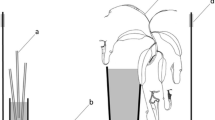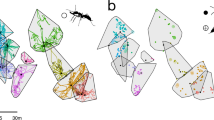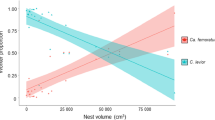Abstract
The balance between costs and benefits is expected to drive associations between species. While these balances are well understood for strict associations, we have no insights to which extent they determine facultative associations between species. Here, we quantified the costs of living in a facultative association, by studying the effects of red wood ants on the facultatively associated isopod Porcellio scaber. Porcellio scaber frequently occurred in and near hostile red wood ant nests and might outnumber obligate nest associates. The facultative association involved different costs for the isopod. We found that the density of the isopod decreases near the nest with higher ant traffic. Individuals in and near the nest were smaller than individuals further away from the nest. Smaller individuals were also found at sites with higher ant traffic. A higher proportion of wounded individuals was found closer to the nest and with higher ant traffic. We recorded pregnant females and juveniles in the nest suggesting that the life cycle can be completed inside the nests. Lab experiments showed that females died sooner and invested less in reproduction in presence of red wood ants. Porcellio scaber rarely provoked an aggression response, but large numbers were carried as prey to the nest. These preyed isopods were mainly dried out corpses. Our results showed that the ant association incurred several costs for a facultative associate. Consequently, red wood ant nests and their surrounding territory act as an alternative habitat where demographic costs are offset by a stable resource provisioning and protection.





Similar content being viewed by others
Availability of data and material
Datasets will be deposited at https://github.com/tjparmen/Dissecting-the-costs-of-a-facultative-symbiosis upon acceptance.
Code availability
The code to run the analyses is available from the corresponding author on reasonable request.
References
Baardsen LF, De Bruyn L, Adriaensen F et al (2021) No overall effect of urbanization on nest-dwelling arthropods of great tits (Parus major). Urban Ecosyst 24:959–972. https://doi.org/10.1007/s11252-020-01082-3
Barclay RMR, Brigham RM (1991) Prey detection, dietary niche breadth, and body size in bats: why are aerial insectivorous bats so small? Am Nat 137:693. https://doi.org/10.1086/285188
Bates D, Mächler M, Bolker B, Walker S (2015) Fitting linear mixed-effects models using lme4. J Stat Softw 67:1–48
Bayley M, Baatrup E (1996) Pesticide uptake and locomotor behaviour in the woodlouse: an experimental study employing video tracking and 14C-labelling. Ecotoxicology 5:35–45. https://doi.org/10.1007/BF00116322
Blanckenhorn WU (2000) The evolution of body size: what keeps organisms small? Q Rev Biol 75:385–407
Boer P (2021) De Nederlandse mieren. https://www.nlmieren.nl/websitepages/WOODANTMOUNDS.html. Accessed 26 Oct 2021
Boucher D (1985) The biology of mutualism: ecology and evolution. Oxford University Press, New York
Brooks M, Kristensen K, van Benthem K et al (2017) glmmTMB balances speed and flexibility among packages for zero-inflated generalized linear mixed modeling. R J 9:378–4000
Calhôa CF, Soares AMVM, Loureiro S (2012) Effects on survival and reproduction of Porcellio dilatatus exposed to different Cd species. Ecotoxicology 21:48–55. https://doi.org/10.1007/s10646-011-0762-6
Castillo M, Kight S (2005) Response of terrestrial isopods, Armadillidium vulgare and Porcellio laevis (Isopoda: Oniscidea) to the ant Tetramorium caespitum: morphology, behavior and reproductive success. Invertebr Reprod Dev 3:183–190
Cazzolla Gatti R, Messina G, Tiralongo F et al (2020) Learning from the environment: how predation changes the behavior of terrestrial Isopoda (Crustacea Oniscidea). Ethol Ecol Evol 32:29–45. https://doi.org/10.1080/03949370.2019.1640799
Cembrowski AR, Tan MG, Thomson JD, Frederickson ME (2014) Ants and ant scent reduce bumblebee pollination of artificial flowers. Am Nat 183:133–139. https://doi.org/10.1086/674101
Dallinger R, Prosi F (1988) Heavy metals in the terrestrial isopod Porcellio scaber Latreille. II. Subcellular fractionation of metal-accumulating lysosomes from hepatopancreas. Cell Biol Toxicol 4:97–109. https://doi.org/10.1007/BF00141289
De Smedt P, Baeten L, Berg MP et al (2018) Desiccation resistance determines distribution of woodlice along forest edge-to-interior gradients. Eur J Soil Biol 85:1–3. https://doi.org/10.1016/j.ejsobi.2017.12.002
De Smedt P, Boeraeve P, Arijs G, Segers S (2020) De landpissebedden van België. Spinicornis, Bonheiden
Dekoninck W, Ignace D, Vankerkhoven F, Wegnez P (2012) Verspreidingsatlas van de mieren van België. Bull La Société R Belge D’entomologie/bulletin Van K Belgische Ver Voor Entomol 148:95–186
Depa Ł, Kaszyca-Taszakowska N, Taszakowski A, Kanturski M (2020) Ant-induced evolutionary patterns in aphids. Biol Rev 95:1574–1589. https://doi.org/10.1111/brv.12629
Dixie B, White H, Hassall M (2015) Effects of microclimate on behavioural and life history traits of terrestrial isopods: Implications for responses to climate change. Zookeys 2015:145–157. https://doi.org/10.3897/zookeys.515.9399
Doebeli M, Knowlton N (1998) The evolution of interspecific mutualisms. Proc Natl Acad Sci USA 95:8676–8680. https://doi.org/10.1073/pnas.95.15.8676
Domisch T, Finér L, Neuvonen S et al (2009) Foraging activity and dietary spectrum of wood ants (Formica rufa group) and their role in nutrient fluxes in boreal forests. Ecol Entomol 34:369–377. https://doi.org/10.1111/j.1365-2311.2009.01086.x
Donisthorpe HSJK (1927) The guests of British ants, their habits and life-histories. George Routledge and Sons, London
Driessen GJJ, Van Raalte AT, De Bruyn GJ (1984) Cannibalism in the red wood ant, Formica polyctena (Hymenoptera: Formicidae). Oecologia 63:13–22
Eickwort G (1990) Associations of mites with social insects. Annu Rev Entomol 35:469–488. https://doi.org/10.1146/annurev.ento.35.1.469
Ernsting G, Fokkema D (1983) Antennal damage and regeneration in springtails (Collembola) in relation to predation. Netherlands J Zool 33:476–484
Fischer E, Farkas S, Hornung E, Past T (1997) Sublethal effects of an organophosphorous insecticide, dimethoate, on the isopod Porcellio scaber Latr. Comp Biochem Physiol - C Pharmacol Toxicol Endocrinol 116:161–166. https://doi.org/10.1016/S0742-8413(96)00164-8
Frouz J, Jílková V, Sorvari J (2016) Contribution of wood ants to nutrient cycling and ecosystem function. In: Stockan J, Robinson E (eds) Wood ant ecology and conservation. Cambridge University Press, Cambridge, pp 207–220
Gösswald K (1989) Die Waldameise Band 2 Die Waldameise im Ökosystem Wald, ihr Nutzen und ihre Hege. Aula-Verlag, Wiesbaden
Haemig PD (1992) Competition between ants and birds in a Swedish Forest. Oikos 65:479–483. https://doi.org/10.2307/3545565
Halaj J, Ross DW, Moldenke AR (1997) Negative effects of ant foraging on spiders in Douglas-fir canopies. Oecologia 109:313–322. https://doi.org/10.1007/s004420050089
Hartig F (2020) DHARMa: Residual diagnostics for hierarchical regression models. R package version 0.4.4.
Hawes C, Stewart A, Evans H (2002) The impact of wood ants (Formica rufa) on the distribution and abundance of ground beetles (Coleoptera: Carabidae) in a Scots pine plantation. Oecologia 131:612–619. https://doi.org/10.1007/s00442-002-0916-6
Hawes C, Evans HF, Stewart AJA (2013) Interference competition, not predation, explains the negative association between wood ants (Formica rufa) and abundance of ground beetles (Coleoptera: Carabidae). Ecol Entomol 38:315–322. https://doi.org/10.1111/een.12021
Hegarty KG, Kight SL (2014) Do predator cues influence turn alternation behavior in terrestrial isopods Porcellio laevis Latreille and Armadillidium vulgare Latreille? Behav Processes 106:168–171. https://doi.org/10.1016/j.beproc.2014.06.005
Hölldobler B, Wilson EO (1990) The ants. Harvard University Press, Cambridge
Hughes DP, Pierce NE, Boomsma JJ (2008) Social insect symbionts: evolution in homeostatic fortresses. Trends Ecol Evol 23:672–677. https://doi.org/10.1016/j.tree.2008.07.011
Jäntti A, Suorsa P, Hakkarainen H et al (2007) Within territory abundance of red wood ants Formica rufa is associated with the body condition of nestlings in the Eurasian treecreeper Certhia familiaris. J Avian Biol 38:619–624. https://doi.org/10.1111/j.2007.0908-8857.03926.x
Kärcher MH, Ratnieks FLW (2010) Honey bee guards recognise allospecific intruders via “different odours” not “harmful-intruder odours.” J Apic Res 49:270–277. https://doi.org/10.3896/IBRA.1.49.3.07
Kistner DH (1982) The social insects’ bestiary. In: Hermann HR (ed) Social insects, vol 3. Academic Press, London, pp 1–244
Kronauer DJC, Pierce NE (2011) Myrmecophiles. Curr Biol 21:208–209. https://doi.org/10.1016/j.cub.2011.01.050
Kurek P, Nowakowski K, Rutkowski T et al (2020) Underground diversity: Uropodina mites (Acari: Mesostigmata) from European badger (Meles meles) nests. Exp Appl Acarol 82:503–513. https://doi.org/10.1007/s10493-020-00563-6
Kuznetsova A, Brockhoff P, Christensen R (2017) lmerTest Package: Tests in linear mixed effects models. J Stat Softw 82:1–26
Lardies MA, Carter MJ, Bozinovic F (2004) Dietary effects on life history traits in a terrestrial isopod: The importance of evaluating maternal effects and trade-offs. Oecologia 138:387–395. https://doi.org/10.1007/s00442-003-1447-5
Lavy D, Van Rijn MJ, Zoomer HR, Verhoef HA (2001) Dietary effects on growth, reproduction, body composition and stress resistance in the terrestrial isopods Oniscus asellus and Porcellio scaber. Physiol Entomol 26:18–25. https://doi.org/10.1046/j.1365-3032.2001.00211.x
Lenth RV (2016) Least-squares means: the R Package lsmeans. J Stat Softw 69:1–33. https://doi.org/10.18637/jss.v069.i01
Lenth R V (2021) emmeans: Estimated marginal means, aka least-squares means. R package version 1.7.0. https://CRAN.R-project.org/package=emmeans
Loones J, Maelfait J, Van Rhijn J et al (2008) De rode bosmier in Vlaanderen: voorkomen, bedreigingen en herstelmaatregelen aan de hand van een detailstudie in de Sixtusbossen (Poperinge-Vleteren). Rapporten van het Instituut voor Natuur- en Bosonderzoek 2008 (INBO.R.2008.01). Instituut voor Natuur en Bosonderzoek, Brussel
Maák IE, Sondej I, Juhász O et al (2021) Unexpected distribution of subordinates around nests of the wood ants. Acta Oecologica 110:103709. https://doi.org/10.1016/j.actao.2021
Mueller UG, Gerardo NM, Aanen DK et al (2005) The evolution of agriculture in insects. Annu Rev Ecol Evol Syst 36:563–595. https://doi.org/10.1146/annurev.ecolsys.36.102003.152626
Myczko Ł, Kurek P, Tryjanowski P et al (2021) Where to overwinter: burrows of medium-sized carnivores as winter places for invertebrates in temperate environment. Ecol Entomol 46:1177–1184. https://doi.org/10.1111/een.13062
Novgorodova TA (2005) Red wood ants (Formicidae) impact on multi-species complexes of aphids (Aphididae) in the forest-park zone of Novosibirsk. Euroasion Entomol J 4:117–120
O’Keefe ST (2000) Ant-like stone beetles, ants, and their associations (Coleoptera: Scydmaenidae; Hymenoptera: Formicidae; Isoptera). J New York Entomol Soc 108:273–303
Ospina B, Jonathan J, Lerma JM (2022) Intruders in the nest : Interaction of Attaphila paucisetosa (Blattodea : Blaberoidea) with Atta cephalotes Workers (Hymenoptera: Formicidae). J Insect Behav. https://doi.org/10.1007/s10905-022-09794-4
Paracer S, Ahmadjian V (2000) Symbiosis: an introduction to biological associations, 2nd edn. Oxford University Press, New York
Parmentier T (2020) Guests of social insects. In: Starr C (ed) Encyclopaedia of social insects. Springer, Cham
Parmentier T, Dekoninck W, Wenseleers T (2014) A highly diverse microcosm in a hostile world: a review on the associates of red wood ants (Formica rufa group). Insectes Soc 61:229–237. https://doi.org/10.1007/s00040-014-0357-3
Parmentier T, Dekoninck W, Wenseleers T (2015a) Metapopulation processes affecting diversity and distribution of myrmecophiles associated with red wood ants. Basic Appl Ecol 16:553–562. https://doi.org/10.1016/j.baae.2015.04.008
Parmentier T, Dekoninck W, Wenseleers T (2015b) Context-dependent specialization in colony defence in the red wood ant Formica rufa. Anim Behav 103:161–167. https://doi.org/10.1016/j.anbehav.2015.02.023
Parmentier T, Dekoninck W, Wenseleers T (2016a) Survival of persecuted myrmecophiles in laboratory nests of different ant species can explain patterns of host use in the field (Hymenoptera : Formicidae). Myrmecol News 23:71–79
Parmentier T, Dekoninck W, Wenseleers T (2016b) Do well-integrated species of an inquiline community have a lower brood predation tendency? A test using red wood ant myrmecophiles. BMC Evol Biol 16:12. https://doi.org/10.1186/s12862-016-0583-6
Parmentier T, Dekoninck W, Wenseleers T (2017) Arthropods associate with their red wood ant host without matching nestmate recognition cues. J Chem Ecol 43:644–661. https://doi.org/10.1007/s10886-017-0868-2
Parmentier T, De Laender F, Wenseleers T, Bonte D (2018) Prudent behavior rather than chemical deception enables a parasite to exploit its ant host. Behav Ecol 29:1225–1233. https://doi.org/10.1093/beheco/ary134
Parmentier T, De Laender F, Bonte D (2020) The topology and drivers of ant – symbiont networks across Europe. Biol Rev 95:1664–1688. https://doi.org/10.1111/brv.12634
Parmentier T, Claus R, De Laender F, Bonte D (2021) Moving apart together: co-movement of a symbiont community and their ant host, and its importance for community assembly. Mov Ecol 9:25. https://doi.org/10.1186/s40462-021-00259-5
Parmentier T (2010) Taakverdeling en voedselecologie bij de werksters van Formica rufa en Formica polyctena. Master thesis, Department of Biology, Ghent University, Ghent, Belgium
Patton WK (1994) Distribution and ecology of animals associated with branching corals (Acropora spp.) from the Great Barrier Reef, Australia. Bull Mar Sci 55:193–211
Pierce N, Braby M, Heath A et al (2002) The ecology and evolution of ant association in the Lycaenidae (Lepidoptera). Annu Rev Entomol 47:733–771
Rettenmeyer CW, Rettenmeyer ME, Joseph J, Berghoff SM (2011) The largest animal association centered on one species: the army ant Eciton burchellii and its more than 300 associates. Insectes Soc 58:281–292. https://doi.org/10.1007/s00040-010-0128-8
Reznikova Z, Dorosheva H (2004) Impacts of red wood ants Formica polyctena on the spatial distribution and behavioural patterns of ground beetles (Carabidae). Pedobiologia 48:15–21. https://doi.org/10.1016/j.pedobi.2003.06.002
Robertson BA, Hutto RL (2006) A framework for understanding ecological traps and an evaluation of existing evidence. Ecology 87:1075–1085
Robinson NA, Robinson EJH (2013) Myrmecophiles and other invertebrate nest associates of the red wood ant Formica rufa (Hymenoptera Formicidae) in Northwest England. Br J Entomol Nat Hist 26:67–88
Robinson EJH, Stockan JA, Iason GR (2016) Wood ants and their interactions with other organisms. In: Stockan J, Robinson E (eds) Wood ant ecology and conservation. Cambridge University Press, Cambridge, pp 177–207
Rocha F, Lachaud J, Pérez-lachaud G (2020) Myrmecophilous organisms associated with colonies of the ponerine ant Neoponera villosa (Hymenoptera: Formicidae) nesting in Aechmea bracteata bromeliads: a biodiversity hotspot. Myrmecol News 30:73–92
Schoener TW (1979) Inferring the properties of predation and other injury-producing agents from injury frequencies. Ecology 60:1110–1115
Seifert B (2007) Die Ameisen Mittel- und Nordeuropas. lutra Verlags- und Vertriebsgesellschaft, Görlitz
Skinner GJ (1980) The feeding habits of the wood-ant, Formica rufa (Hymenoptera: Formicidae), in limestone woodland in North-West England. J Anim Ecol 49:417–433. https://doi.org/10.2307/4255
Sörensen U, Schmidt GH (1987) Vergleichende Untersuchungen zum Beuteeintrag der Waldameisen (Genus: Formica, Hymenoptera) in der Bredstedter Geest (Schleswig-Holstein). J Appl Entomol 103:153–177. https://doi.org/10.1111/j.1439-0418.1987.tb00974.x
Stadler B, Fiedler K, Kawecki TJ, Weisser WW (2001) Costs and benefits for phytophagous myrmecophiles: When ants are not always available. Oikos 92:467–478. https://doi.org/10.1034/j.1600-0706.2001.920308.x
Stockan JA, Robinson EJH (2016) Wood ant ecology and conservation. Cambridge University Press, Cambridge
Sutton SL (1980) Woodlice. Pergamon Press Ltd, England
Trigos-Peral G, Juhász O, Kiss PJ et al (2021) Wood ants as biological control of the forest pest beetles Ips spp. Sci Rep 11:1–10. https://doi.org/10.1038/s41598-021-96990-5
Uppstrom KA (2010) Mites (Acari) associated with the ants (Formicidae) of Ohio and the harvester ant, Messor pergandei, of Arizona. Master thesis, Ohio State University, USA
van der Heijden MGA, Martin FM, Selosse MA, Sanders IR (2015) Mycorrhizal ecology and evolution: The past, the present, and the future. New Phytol 205:1406–1423. https://doi.org/10.1111/nph.13288
Venables WN, Ripley BD (2002) Modern applied statistics with S, 4th edn. Springer, New York
Von Beeren C, Brückner A, Hoenle PO et al (2021) Multiple phenotypic traits as triggers of host attacks towards ant symbionts: body size, morphological gestalt, and chemical mimicry accuracy. Front Zool. https://doi.org/10.1186/s12983-021-00427-8
White JW, Grigsby CJ, Warner RR (2007) Cleaning behavior is riskier and less profitable than an alternative strategy for a facultative cleaner fish. Coral Reefs 26:87–94. https://doi.org/10.1007/s00338-006-0161-2
Witte V, Leingärtner A, Sabaß L et al (2008) Symbiont microcosm in an ant society and the diversity of interspecific interactions. Anim Behav 76:1477–1486. https://doi.org/10.1016/j.anbehav.2008.05.010
Zidar P, Kos M, Ilič E et al (2019) Avoidance behaviour of isopods (Porcellio scaber) exposed to food or soil contaminated with Ag- and CeO2- nanoparticles. Appl Soil Ecol 141:69–78. https://doi.org/10.1016/j.apsoil.2019.05.011
Zingg S, Dolle P, Voordouw MJ, Kern M (2018) The negative effect of wood ant presence on tick abundance. Parasit Vectors 11:1–9. https://doi.org/10.1186/s13071-018-2712-0
Acknowledgements
We thank the Flemish Agency for Nature and Forest (ANB) and the provincie West-Vlaanderen for granting permission to sample at their sites
Funding
This work was supported by FWO and FNRS (1203020N/30257865 to TP).
Author information
Authors and Affiliations
Contributions
JZ, FDW, LDB and TP conceived and designed the experiments. JZ, FDW and TP performed the experiments. LDB and DB participated in the coordination of the study. All authors analyzed the data. JZ and TP wrote the manuscript, FDW, LDB and DB critically revised the manuscript.
Corresponding author
Ethics declarations
Conflict of interest
Not applicable.
Ethics approval
Not applicable.
Consent to participate
Not applicable.
Consent for publication
Not applicable.
Additional information
Communicated by Stefan Scheu.
Supplementary Information
Below is the link to the electronic supplementary material.
Rights and permissions
About this article
Cite this article
Zarka, J., De Wint, F.C., De Bruyn, L. et al. Dissecting the costs of a facultative symbiosis in an isopod living with ants. Oecologia 199, 355–366 (2022). https://doi.org/10.1007/s00442-022-05186-9
Received:
Accepted:
Published:
Issue Date:
DOI: https://doi.org/10.1007/s00442-022-05186-9




